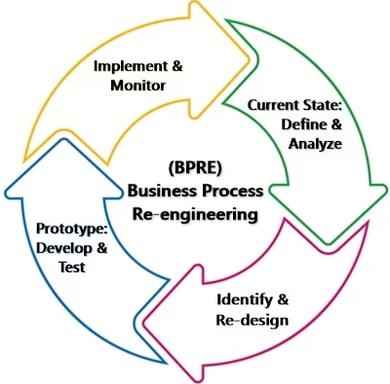A Deeper Dive into Business Process Re-engineering Implementation
This blog post aims to provide some insights into what is involved in Business Process Re-engineering Implementation


In our previous post, we unraveled the power of Business Process Re-engineering (BPR), the bold approach to reinventing your business from the core. Today, we dive deeper, exploring the practical steps you can take to transform your vision into reality through successful BPR implementation.
Phase 1: Laying the Foundation:
Vision and Roadmap: Clearly define your desired future state, outlining the goals and expected benefits of BPR. Create a roadmap with milestones and timelines to guide your journey.
Process Selection: Choose an initial process with high impact potential and manageable complexity. Starting small allows for learning and adjustments before tackling larger challenges.
Team Assembly: Build a dedicated BPR team with expertise in process analysis, redesign, change management, and technology implementation. This diverse team ensures a holistic approach.
Stakeholder Engagement: Get everyone on board! Communicate the BPR initiative, its goals, and potential impact to all stakeholders, fostering buy-in and support.
Phase 2: Deep Dive and Redesign:
Current State Analysis: Map your existing process in detail, identifying bottlenecks, redundancies, and inefficiencies. Utilize data analysis, interviews, and process mapping tools to gain a comprehensive understanding.
Root Cause Identification: Don't just treat symptoms; delve deeper to uncover the root causes of identified issues. This ensures your redesigned process tackles the core problems, not just superficial fixes.
Redesign and Innovation: Unleash your creativity! Brainstorm and evaluate potential solutions, embracing new technologies and innovative approaches to optimize the process. Think automation, lean principles, and cross-functional collaboration.
Prototyping and Validation: Don't jump straight into full-scale implementation. Build prototypes or pilot projects of your redesigned process to test its functionality, gather feedback, and refine your approach before deployment.
Phase 3: Making it Real:
Process Implementation: Now's the time to put your plan into action! Train employees on the new process, update systems and technologies, and ensure seamless integration with existing workflows.
Change Management: Embrace the human side of change. Address concerns, provide ongoing support, and celebrate successes to keep everyone engaged and committed to the new way of working.
Monitoring and Evaluation: Continuous improvement is key. Monitor the performance of your new process using key metrics, identify areas for further optimization, and adapt as needed.
With careful planning, dedicated execution, and a culture of continuous improvement, you can successfully navigate the transformative path of BPR and unlock the full potential of your business.
Here are some additional tips for successful BPR implementation:
Invest in training and communication: Make sure everyone understands the new process, its benefits, and their role in its success.
Embrace flexibility: Be prepared to adapt your approach as you learn and encounter unforeseen challenges.
Celebrate successes: Recognize and reward teams for their contributions to keep motivation high throughout the journey.
Share your experiences: Connect with other organizations that have undergone BPR to learn from their successes and challenges.
BPR is a powerful tool, but it's not magic. It requires hard work, dedication, and a willingness to embrace change. However, the rewards are significant, allowing you to build a more efficient, agile, and customer-centric business.
